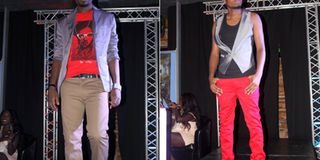Getting fashionable with the times

Right, skinny jeans, and cardigans are stylish today, Left, a blazer is a great casual option. Photos by ISMAIL KEZAALA AND Jude Katende
What you need to know:
Designers agree that men’s fashion does not change to drastically but the small nuances need to be kept in mind or else one could be caught in a time warp.
Fashion is one of those aspects of life that change without warning. Unless, a friend of yours is always on the lookout for what is in and what is out, some trends just escape our eyes. If you are old enough then you should know that something called suspenders is of for yesteryears.
Some of us used to adore these “two strings” stretched over in front at either side and forming an X at the back. They held our trousers and were not supposed to be worn with belts though some men broke this rule. If you watched Sanford and Son, a TV sitcom starring the late American actor, John Elroy Sanford (Redd Foxx), I am sure you remember Sanford’s love for suspenders. That the sitcom aired in the 70s in the US, which shows how old the style is.
Millennium fashion
Fast forward to the millennium. I have not seen suspenders in a long time. They could still be cool in America (Larry King and rapper Andre 3000 are fans) but not here in Uganda. But who says fashion dies forever? In fact, it keeps reinventing itself.
Many trends are gradually coming back including retro shirts. The pointed shoes are not a recent thing. In the past, they were nicknamed ‘sharpees.’ There are some timeless fashion items that are hard to see fading away such as cufflinks. Instead, they are improved upon every year. Sleeve garters or sleeve holders meant to keep long sleeves at bay for one to work properly have also somehow vanished, at least in Uganda.
These days, colour is a big issue. According to fashion designer, Latif Madoi, warm colours such as purple and pink are all the rage. He notes that the colours are also available in shoes. Stanley Njambi, a supervisor at Mr Price, says chequered shirts are trending especially for casual wear. He adds that skinny jeans and American khaki pants as well as polo t-shirts and sneakers are also in for men. For those that are fading out, Njambi mentions wide bootleg trousers.
Stella Atal, a fashion designer, says the tight chequered shirts are in as are bright colours also called summer colours, pants with small stripes and fitting trousers without pleats. “These are back from the 1960s and 1970s. Fashion is being recycled. Everything from shoes, hair and bags is being modified,” she notes. She adds that people see these designs flattering their bodies.
Madoi observes that although skinny jeans are in, he personally hates them. “They make men look funny. I have seen some artistes wearing them and I pity them,” he asserts. He prefers baggy jeans which he says are still ‘in.’ “One should wear what flatters their figure; if it does not then it isn’t good at all,” Madoi adds. For him, well-fitting jeans are better. He points out that for shoes, thin soles is the way to go.
“In the past we used to wear thick soles and we called the shoes ‘Nigger.’ Those are no longer fashionable,” he says while showing off a pair he has just designed. For T-shirts, Madoi says those with textual messages are in. Latif notes that office coats/jackets are losing ground to loose fabrics such as summer jackets also called blazers. “They are made from cotton and feel comfortable on the body,” he notes.
Bena Nakaggwa, Floor Manager at the Sylvia Owori shop, says men’s fashion hardly changes. Nakaggwa says most of what is in now is for casual weekend wear and not so much for corporate or office wear. She mentions casual long sleeve sweaters with a light material coming in V and round neck designs, stripped sweaters with buttons and a V-neck. “Body fitting V-neck long-sleeve T-shirts look good for casual wear if worn with jeans. The V-neck short sleeve T-shirts are good on a sunny day,” she observes.
Mechandising
Nakaggwa recommends sport T-shirts (polos) for weekend wear. “They are good with shorts and jeans,” she says. Pricing for most of the products depends on the quality, brand and where one shops. For instance the big watches range from Shs25,000 to Shs100,000 depending on place, t-shirts from Shs25,000 to Shs150,000 or more, sweaters from Shs30,000 to Shs160,000, shades from as low as Shs10,000 to Shs500,000 and more.




